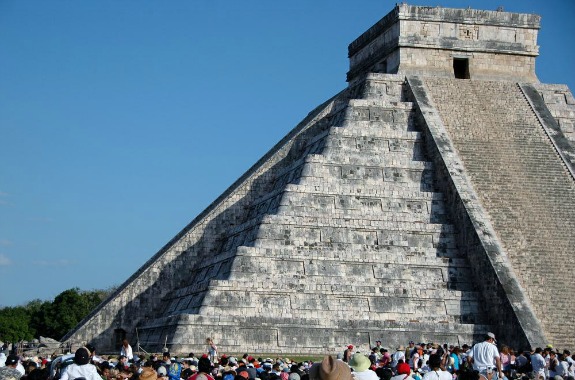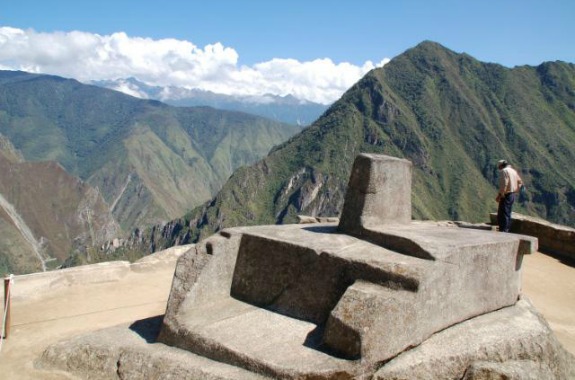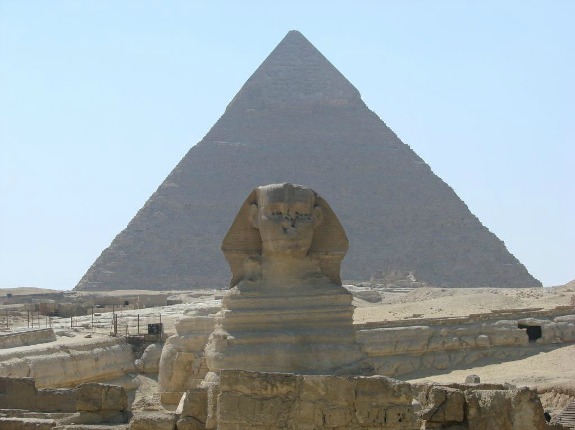The Equinox: See It for Yourself This Weekend
There are many great spots around the globe to observe the celestial phenomena, from Machu Picchu to the Yorkshire moors
The Intihuatana stone at Machu Picchu casts no shadow at noon on either equinox. Photo courtesy of Flickr user snikrap.
On September 22, as the sun nears its zenith in the Peruvian sky, the shadow of a small slab of granite at Machu Picchu disappears at noon. This is no accident. For this rock is called the “hitching post of the sun”—Intihuatana, to the ancient Incas, who celebrated the equinox at this site. Some bright mind among them determined that this day was a special one, and so he—or she—carved the 26-inch-tall stone so that it faces at a very particular northward angle—about 13 degrees, the latitude of Machu Picchu. The effect is that at noon on both the spring and fall equinoxes, for just an instant, the stone’s shadow disappears. The sun, so it seemed to the ancients, was at those moments “hitched” to the end of the stone.
Elsewhere on the equinox, various sites similarly demonstrate ancient cultures’ recognition—and precise understanding—of the sun’s cycles through the sky. In the Yucatán this weekend? Then dog-ear that trashy paperback, drag yourself away from the time-share pool and visit Chichen Itza. Have a seat in the grass with the other sun lovers and watch. Due to the particular geometry and angles of construction of the Kukulcán pyramid, a dramatic shadow undulates down the stairway on the structure’s northern face on both the spring and fall equinoxes. At the base of the stairway are large snake heads carved into the rock, and the effect—which lasts several hours in the afternoon—is of a giant snake descending the pyramid. Not so far away, the Pyramid of the Sun in southern Mexico faces due east—straight at the rising sun, on either the spring or fall equinox. Remember that on only those two days does the sun rise from due east. The spring equinox causes a great stir among New Age sun worshipers, who flock to the Pyramid of the Sun on March 20, believing that “energy” can be tapped from the air on this day at this particular site. In their New Age fervor, these gatherers seem to be having impacts on the site as they trample upon it every March. Helpful tip: Since the autumn equinox is celestially little different than the spring one, it should generate equal energies. So dodge the crowds and make your pilgrimage to this great historical site this weekend. Let us know if you feel the buzz.

On either equinox, the sun casts an undulating snake-like shadow down the staircase on the Kukulcán pyramid’s north face. The shadow appears to connect with the serpent heads set at the base of the monument, indicating this was a very intentional effect of Mayan architects. Photo courtesy of Flickr user ErikBFlom.
In New Mexico? Then Chaco Canyon‘s Sun Dagger site is the ancient observatory for you. Here, ancient Anasazi sky-watchers evidently leaned three slabs of stone against a south-facing rock wall, on which they carved two spirals. Blades of sunlight, passing through the cracks between the slabs, migrate across these etched spirals, and so two corresponding blades of sunlight appear on the rock wall and its spiral etchings. On the summer solstice, a single dagger of light perfectly bisects the larger of the spirals. On the winter solstice, two separate daggers touch the opposing outer edges of the larger spiral. And on the equinoxes, something slightly more complex happens—easily observed in the diagram on this website. An artist named Anna Sofaer reportedly discovered this site in 1977, and by returning throughout the year, observed the passage of the sunlight shafts across the carved spirals. And at the Anasazi ruin at Hovenweep National Monument, set on the border of Utah and Colorado, shafts of sunlight cross spiral rock etchings on the summer solstice. And at a Chumash site in Burro Flats, in southern California, a sliver of light crosses the center point of five concentric rings on the winter solstice. On the same day at a Baja California shrine called La Rumorosa, a blade of sunlight cast through a rock seems to beam from the eyes of a human figure painted on a shaded stone wall.
In Yorkshire at the moment? Then slog across the green-gray moors and take a moment near sunset to visit the biggest boulder in the county, the Hitching Stone—a glacial rock anywhere from 21 to 29 feet thick in any direction and guessed to weigh about 1,000 tons. From this once-sacred location, observers on the equinox will notice that the sun sets directly behind Pendle Hill, directly west of the Hitching Stone. And reportedly on the winter solstice, a person seated on the nearby Winter Hill Stone in the frigid hour before dawn will see the sun come up directly behind the Hitching Stone. Important to note of this landscape is that it occurred naturally and was not created by ancient astronomers (unless the ancients managed to hoist the Hitching Stone and tote it to its current spot). Experts have noted that this Yorkshire location is only lacking a point that would mark the date of the summer solstice. And remember that the dreary weather precludes even seeing the sun most days of the year here, so don’t plan a vacation around this trick of solar astronomy.
In Egypt? Then visit the pyramids, where several great monuments are aligned to honor the sun and stars on either equinox. The sphinx, for one, faces due east, taking in the rising sun on March 20 and September 22. And within the Great Pyramid, a skyward shaft is believed to have pointed directly at the Alpha Draconis star at midnight on the autumn equinox. In and around the year 3000 B.C., Alpha Draconis served as the North Star of the era. Because the stars are slowly migrating in their relation to the Earth, this phenomenon is no longer observed. (Today’s North Star is Polaris.)
Staying home this equinox? Then try this: Tilt a broomstick southward (assuming you’re in the Northern Hemisphere; tilt it northward if you’re south of the Equator) and, using a protractor for assistance, hold it at the exact angle of your location’s latitude. Refer to this chart of the latitude and longitude of major world cities, or this separate chart for the United States and Canada, to determine your latitude. Keep holding that broomstick. Steady now. Don’t move. Just two more hours. Hang in there. OK—get ready, here it comes: At noon, the broomstick will cast no shadow. Amazing!
Or staying up late this weekend? Then this may be the best time of the year to watch the skies for the aurora borealis, or Northern Lights. Mystics like to refer to this phenomenon as “mysterious,” though it makes perfect sense to pragmatic scientific minds. The aurora borealis—which has an austral counterpart over the high southerly latitudes—is caused when a sun flare sends clouds of electrified subatomic particles toward the Earth at millions of miles per hour. Upon crashing into the molecules of the Earth’s atmosphere, energy is transferred between the particles, creating brilliant displays of colorful light. Sun flares occur most often around the equinox. Click here for information of the latest in sun flare activity.
This post was written equally for all people. For on September 22, readers in every hemisphere will share equally in the light of the sun; at every point on Earth, the sun will rise from due east, and 12 hours later set at due west; and at all points on the Earth, the sun will spend 12 hours in the sky. The equinox is a day of global sharing.
/https://tf-cmsv2-smithsonianmag-media.s3.amazonaws.com/accounts/headshot/Off-Road-alastair-bland-240.jpg)


/https://tf-cmsv2-smithsonianmag-media.s3.amazonaws.com/accounts/headshot/Off-Road-alastair-bland-240.jpg)